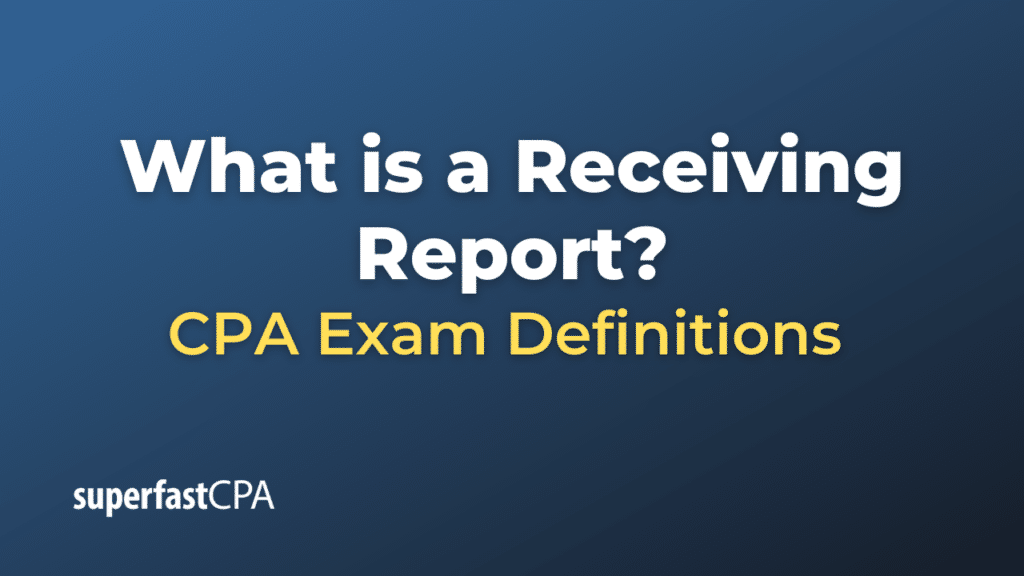Receiving Report
A receiving report is a formal document created by the receiving department of a company to confirm the receipt of goods ordered from a supplier. This report provides a detailed record of the items received, their condition upon arrival, and any discrepancies between the goods ordered and those actually received.
Key elements typically included in a receiving report are:
- Receiving Report Number: A unique identification number for tracking and referencing purposes.
- Date of Receipt: The date on which the goods were received.
- Supplier Name and Address: Information about the company or individual from which the goods were purchased.
- Purchase Order Number: The reference number of the purchase order related to the received goods, which helps in reconciling the goods received with the goods ordered.
- Description of Goods: A detailed list of items received, including product names, model numbers, sizes, colors, etc.
- Quantity Received: The number of items received for each product.
- Condition of Goods: Notes on the state of the received items. This could include any damages, defects, or other notable conditions of the products.
- Discrepancies: Any differences between the goods received and the goods listed on the purchase order, such as missing items, extra items, or damaged goods.
- Receiver’s Name and Signature: The name and signature of the person responsible for receiving and inspecting the goods, which verifies the accuracy of the report.
- Comments or Notes: Additional information or observations made during the receiving process.
The receiving report serves several purposes:
- Verification: It provides a means to verify that the goods received match what was ordered.
- Documentation: It offers a recorded history of received items for accounting and inventory tracking purposes.
- Discrepancy Resolution: In the case of issues like damaged or missing items, the receiving report acts as evidence and helps in resolving discrepancies with the supplier.
- Payment Authorization: It can be used by the accounts payable department to confirm the receipt of goods before processing payment to the supplier.
It’s essential for companies to accurately complete and maintain receiving reports to ensure a smooth flow in their supply chain, financial documentation, and inventory management processes.
Example of a Receiving Report
Let’s walk through a hypothetical example of a receiving report for a company that ordered office supplies.
Receiving Report #: RR-10245
Date of Receipt: August 10, 2023
Supplier: OfficeElite Supplies Inc.
Address: 123 Stationery Lane, Officeville, ST 12345
Purchase Order Number: PO-89765
| Item Description | Ordered Quantity | Received Quantity | Condition | Comments |
|---|---|---|---|---|
| Ergonomic Office Chair, Model E45 | 5 | 5 | Good | None |
| Desktop Printer, Model D100 | 3 | 3 | Good | None |
| A4 Paper Reams | 10 | 9 | Good | 1 ream missing |
| Blue Ballpoint Pens (Pack of 50) | 20 | 20 | 2 packs damaged | 100 pens unusable |
| 32-inch Computer Monitors, Model M320 | 4 | 4 | Good | None |
Discrepancies:
- One ream of A4 paper is missing from the delivered items.
- Two packs of blue ballpoint pens arrived damaged, resulting in 100 unusable pens.
Receiver’s Name: Jane Doe
Signature: [Jane’s signature]
Comments: Supplier to be contacted regarding discrepancies. Replacement for missing and damaged items requested.
In this example, the receiving report clearly details what was ordered versus what was received. Discrepancies are highlighted, and Jane Doe, who verified the delivery, has signed off on the report. This document will be valuable when liaising with the supplier about the discrepancies and can also be used by the accounts payable department to ensure correct payment.













